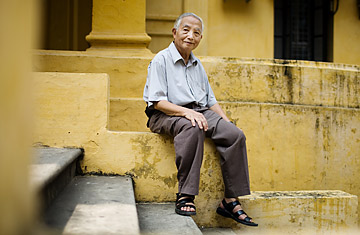
Even Vo Quy appreciates the irony. The Vietnamese zoologist, 78, has spent decades trying to coax life out of the 5 million acres (2 million ha) of forest damaged by American herbicides and bombing campaigns during the war. Yet today, the biggest threat to Vietnam's environment is not the devastation caused by soldiers from a capitalist country but Vietnam's own booming market economy. Factories responsible for the country's torrid growth spew toxins into the sky, and the hunger for farmland and construction materials has led to rampant deforestation. "I try to tell the younger generation that we must conserve nature," says Quy, Vietnam's premier environmentalist. "But young people today like to make money more than taking care of forests."
Vietnam designated its first wildlife reserve back in 1962, but as Quy admits, "it was a little difficult to focus on it since we had a war happening." After the communists emerged victorious in 1975, he helped develop a network of national parks and reserves. Vietnam now boasts 126 protected areas, although enforcement of conservation measures is spotty. Quy also initiated community-based refoliation and agroforestry programs, introducing to Vietnam a grassroots approach that would prove far more effective than the centrally mandated policies of communist officialdom. In 1985, he inaugurated the country's first environmental research center at the University of Hanoi, an institution he helped found in 1956. "We did not have many experts back then," recalls Quy. "So we had to do many things at once."
Indeed, Quy turned himself into a one-man environmental machine. The breadth of his career bespeaks not only the dearth of other Vietnamese naturalists, but Quy's own voracious curiosity. During his spare time, he wrote Birds of Vietnam, the first book on fauna by a Vietnamese in the modern era. The two-volume work includes a species of pheasant that Quy himself discovered in 1964. He also caught sight of a rare migratory crane believed to have gone extinct in Vietnam during the war, and established a reserve to protect the bird. Today, hundreds of these Eastern Sarus Cranes live in Vietnam's wetlands. They average almost six feet (1.8 m), and belong to the world's tallest flying-bird species.
Though he's long past retirement age, Quy remains actively involved in reforestation and conservation projects. He recently toured an area of Vietnam still recovering from the effects of Agent Orange and napalm bombing. He counsels youngsters on pollution and other side effects of industrialization, even as urban teens aspire to own the latest motorcycle or land a job at a high-paying factory. And he warns against a wild-animal trade that is robbing the country's forests of such species as the Giant Muntjac, a barking deer only identified in 1994. "I am quite old," Quy says, "but I will not stop because I have a lot more work to do."